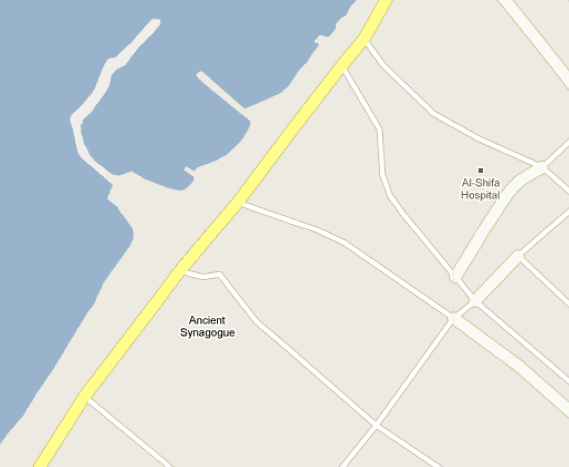Questionable priorities of archeological facts on Google Maps, divisive cross-lingual links on Wikipedia… Are the ideological distortions of history on so-called balanced online services here to stay?
As I was working with Laila El-Haddad on the 2009 version of You Are Not Here, we were looking for interesting locations to feature on our mediated/dislocated tour. Using Google Maps, I was particularly interested in what seems to be an important historic location:

[Available at publish time, in case it changes, click to see on Google Maps.]
The Old Synagogue in Gaza
The ancient synagogue in Gaza picked my attention, I knew there used to be a Jewish community in Gaza (as I was well informed by the the Israeli right around the time of the disengagement), but I didn’t know about an old synagogue and wondered if it might be an interesting spot in the tour. But as much as I was trying I couldn’t find much information about this synagogue. I finally found that this synagogue was built by the Jewish community in the city 1500 years ago and was an important archeological find, especially for its mosaic work featuring the name “David”, in Hebrew letters.
This was indeed a spot worth mentioning but I was wondering though how come the other archeological relics like the Great Omari Mosque or even Napoleon’s Castle were omitted from the map. And how come the ancient synagogue in Gaza is mentioned on the map, while other synagogues like the older one (and arguably of a higher archeological importance) in Tzipori are not mentioned on the Google map.
Antedon? WTF?
It left me curious but not too suspicious, as many other synagogues are indeed mentioned on Google Maps. What through me was the mention of “Horvat Antedon” to the North of the Shati refugee camp in Gaza. I have never heard of Antedon and was wondering if there are any relics there. Well apparently Antedon is a city built by the Jewish king Herod in the first century BC. It is definitely not an important part of history and its location is only apparently not even known but is only guessed. There are no archeological artifacts to spot the location of Antedon and it is unclear how it made it to the map. Including the guessed location in the map more of an opinionated annotation (saying “Jews used to live here”) than anything else.

[Available at publish time, in case it changes, Click to see on Google Maps.]
Zionist Conspiracy? No…

I do not mean to imply any sort of “Zionist Conspiracy” here, not at all… I rather want to use this example to emphasize how the so called unbiased and technical description of the world which is a part of Google’s agenda is not and probably cannot be devoid of ideology. It is embedded in our attempt to describe the world, and no one is immune to it. Google still gets its maps from third parties, and that information is mentioned at the bottom of the map: “Map data ©2009 Mapa GISrael, ORION-ME, AND, LeadDog Consulting, Europa Technologies”. Mapa GISrael is describing the land from an Israeli perspective, just as much as the name definition and the sidebar on the “Palestine” article in Wikipedia links to the Hebrew article “ארץ ישראל” (“Eretz Israel” – The land of Israel).
As much as we might be disturbed by these instances of clear ideological decisions directing a so-called trust-worthy fact, I actually find them hopeful. It just shows how essential our critical thinking is and how it could never be replaced by cold alienated technology. It does however call for a wider media literacy and a critical reading of the map(s).
Interesting work you’re doing. The use of political geography is very common inside Israel as well, especially when talking about the occupation between lefties and righties.
The Arab village “sheik munis” is a right wings favorite site (where now lays TAU) when trying to point out that “Everything is occupied”. Its not on maps but in the political geographical narrative.
Maps play an important role in the indoctrination of young kids in Israel and Palestine. In majority of Israeli classrooms the map is a fake one.
There is no Unbiased info.
Keep up your great work. I enjoy it from afar.
Harkavi – yud bet 6 galili
Thanks Eyal, this “everything is occupied” is well described by Leibowitz in the video I referred to in my post To Whom Does the Land Belong? a few weeks ago. Leibowitz makes the point that no people have no right over no land. I think this “right” terminology is a huge part of the problem.